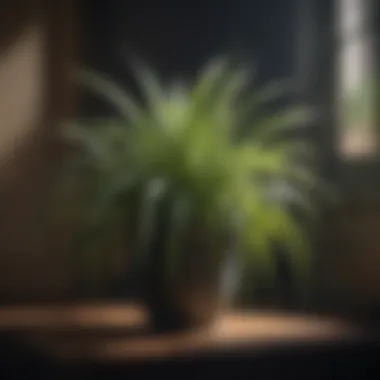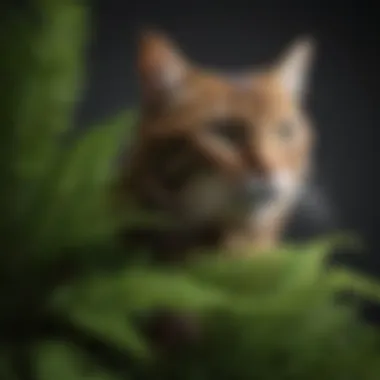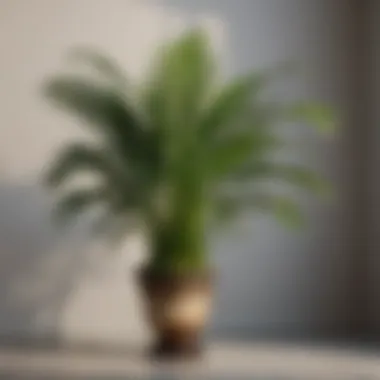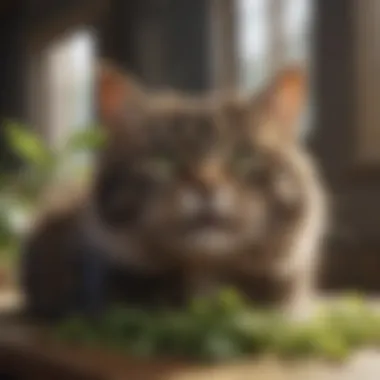Enhance Your Home with Safe Indoor Plants for Cats


Materials:
To create a pet-friendly indoor environment, ensure you have the following materials:
- Spider Plant: 1 potted plant
- Areca Palm: 2 potted plants
- Boston Fern: 1 potted plant
- African Violet: 1 potted plant
DIY Steps:
Follow these step-by-step instructions to introduce safe indoor plants for your cat:
- Choose a suitable location for each plant based on light and humidity requirements.
- Repot the plants if necessary, using well-draining soil.
- Water the plants regularly, ensuring the soil remains damp but not waterlogged.
- Monitor the plants for any signs of distress or toxicity to cats.
Technical Aspects:
Enhance your DIY project with these key technical aspects:
- Required Tools: Watering can, soil, pots
- Timing Specifics: Water plants weekly, repot annually
- Critical Techniques: Propagation, pest control
DIY Project Process:
Execute the following sequential steps to maintain a harmonious environment:
- Place the spider plant in a well-lit area away from direct sunlight.
- Position the Areca Palms in a spot with indirect light and regular misting.
- Arrange the Boston Fern in a humid location with indirect sunlight.
- Showcase the African Violet in a bright area shielded from harsh sun rays.
Troubleshooting Tips:
In case of issues, consider these troubleshooting tips:


- Yellowing leaves may indicate overwatering.
- Wilting leaves could signal underwatering.
- Brown tips might result from low humidity.
Introduction
In the realm of creating a harmonious living space for both feline companions and humans, the choice of indoor plants plays a crucial role. This article delves into the vital aspect of incorporating indoor plants that are safe for cats. By exploring safe plant options, cat owners can enhance their indoor environment with greenery without compromising the well-being of their beloved pets.
Understanding the Importance of Pet-safe Plants
Benefits of indoor plants for air quality
Indoor plants not only add aesthetic value to our spaces but also serve a significant function in improving indoor air quality. The presence of plants indoors can help purify the air by absorbing toxins and releasing oxygen, creating a healthier environment for both cats and humans. One key characteristic of indoor plants' air-purifying quality is their ability to reduce pollutants like formaldehyde and benzene, contributing to a cleaner and fresher indoor atmosphere. This key feature makes them a popular and beneficial choice for cat owners looking to enhance their living spaces while prioritizing air quality. Despite these advantages, it is essential to acknowledge the maintenance required for indoor plants to sustain their air-purifying benefits.
Risks of toxic plants to cats
While indoor plants offer numerous benefits, certain plant species can pose risks to our feline companions if ingested. Toxic plants can cause a range of health issues for cats, from mild gastrointestinal upset to severe toxicity, depending on the plant species and the amount consumed. Recognizing the key characteristic of toxic plants and understanding their potential dangers is crucial for cat owners seeking to create a safe indoor environment. This awareness allows pet owners to identify and remove toxic plants from their homes, ensuring the well-being and safety of their feline friends.
Creating a Safe Indoor Environment
Guidelines for choosing safe plants
When selecting indoor plants for a cat-friendly environment, it is essential to consider pet-safe options that are non-toxic to cats. Guidelines for choosing safe plants involve researching plant toxicity levels, opting for cat-friendly varieties such as spider plants and palms, and avoiding species known to be harmful to felines. One key characteristic of safe plants for cats is their non-toxic nature, providing peace of mind to pet owners concerned about their cats' well-being. This unique feature makes safe plants an advantageous choice for those looking to create a pet-friendly indoor oasis.
Placement tips for cat-friendly spaces
In addition to choosing safe plants, the placement of indoor greenery plays a vital role in creating a cat-friendly space. Placing plants in elevated locations, using hanging planters, and securing pots in stable positions help prevent cats from accessing and potentially damaging the plants. This key characteristic of strategic plant placement not only keeps the plants out of reach of curious felines but also enhances the overall aesthetics of the space. By incorporating these placement tips, cat owners can design a cat-friendly indoor environment that promotes harmony between plants and pets.
Non-Toxic Indoor Plants for Cats
Palms and Ferns


Areca Palm
Areca Palm stands out as a prominent choice among non-toxic indoor plants for cats. Known for its graceful appearance and air-purifying qualities, the Areca Palm brings a touch of tropical elegance to indoor spaces. Its resilience and easy maintenance further contribute to its popularity among plant enthusiasts looking to create cat-friendly environments.
Parlor Palm
The Parlor Palm caters to both aesthetics and safety when it comes to indoor foliage. Its compact size and lush, feathery fronds make it a delightful addition to any cat-friendly setting. This plant's low light requirements and tolerance for occasional neglect make it an ideal choice for cat owners seeking an effortless yet attractive botanical companion.
Boston Fern
Boston Fern emerges as a classic choice for cat-safe indoor greenery. With its arching fronds and vibrant green foliage, this fern brings a refreshing burst of nature indoors. Its capacity to thrive in high humidity levels aligns perfectly with indoor environments, making it a beloved option for those prioritizing both cat safety and plant aesthetics.
Succulents and Cacti
Hens and Chicks
Among the array of succulents safe for cats, Hens and Chicks stand out for their charming rosette formations and minimal care requirements. Their compact growth habit and drought tolerance make them an excellent choice for cat-inhabited spaces, adding a touch of desert allure while ensuring feline safety.
Christmas Cactus
The Christmas Cactus presents a festive and safe addition to indoor plant collections. Known for its vibrant blooms and low-maintenance nature, this succulent brightens up living spaces without posing a threat to curious feline companions. Its ability to thrive with minimal attention makes it a popular choice for cat owners seeking a hassle-free plant companion.
Burro's Tail
Burro's Tail succulent is a unique and eye-catching option for those eager to incorporate safe greenery around cats. Its trailing stems and plump, trailing leaves create an intriguing visual appeal while catering to the needs of both plant enthusiasts and pet owners. The Burro's Tail's resilience and drought tolerance make it an excellent choice for indoor settings where cat safety is a top priority.
Herbs and Grasses
Catnip


Catnip stands out as more than just a feline delight; it is also a safe and enriching addition to indoor spaces inhabited by cats. Its aromatic leaves and stimulating properties make it a favorite among cats without compromising their health. Cat owners can enjoy watching their pets interact with Catnip while having peace of mind knowing that this herb poses no harm to their beloved companions.
Spider Plant
For cat owners seeking a safe yet visually striking plant for their homes, the Spider Plant offers an ideal solution. With its air-purifying qualities and distinctive foliage, this plant enhances indoor spaces while remaining non-toxic to cats. The Spider Plant's adaptability to various light conditions and ease of propagation make it a practical and appealing choice for feline-friendly environments.
Lemongrass
Lemongrass adds a refreshing and safe touch to indoor herb gardens, ensuring a pet-friendly ambiance that cat owners desire. Its citrusy scent, culinary applications, and ornamental value make it a versatile choice for households with cats. The benefits of Lemongrass extend beyond its aesthetic appeal, offering cat-safe greenery that can elevate both indoor spaces and the well-being of pets.
Maintenance Tips for Pet-friendly Plants
Watering and pruning are pivotal practices that contribute significantly to the vitality of your indoor flora. By striking a delicate balance between hydration and soil moisture levels, you empower your plants to thrive without succumbing to the perils of overwatering. In this article, we shed light on the essentiality of this equilibrium, guiding you towards a flourishing indoor garden that captures both aesthetics and safety in equal measure.
Watering and Pruning Practices
Balancing Hydration Without Overwatering
The art of balancing hydration without overwatering stands as a cornerstone in the realm of pet-friendly plant care. This delicate equilibrium ensures that your plants receive adequate moisture without drowning their roots in excess water, which could lead to root rot and other detrimental consequences. By mastering this art, you instill a sense of vigor and vitality in your indoor greenery, fostering an environment where both plants and pets can thrive harmoniously.
Delving deeper into the essence of balancing hydration, we unravel its significance in fortifying the resilience of your plant babies. This practice not only sustains their overall health but also nurtures a bond between nature and nurture within your living space. Embracing the balance of hydration serves as a testament to your commitment towards creating a sustainable and pet-friendly sanctuary brimming with life and vibrancy.
Trimming for Healthy Growth
Trimming for healthy growth emerges as a beacon of light in the journey of nurturing pet-friendly plants. By harnessing the power of strategic trimming, you not only encourage robust growth patterns but also facilitate the development of lush foliage that beckons a sense of tranquility into your abode. This practice aids in promoting air circulation, preventing overcrowding, and rejuvenating the aesthetic appeal of your indoor garden.
Unveiling the multifaceted benefits of trimming, we uncover its capacity to rejuvenate and invigorate your plant companions. Through precise and intentional pruning, you sculpt a landscape of beauty and vitality, where each leaf and stem reflects the tender care and attention lavished upon them. Embrace the art of trimming as a conduit to fostering a flourishing haven for both your feline friends and leafy allies.
Conclusion
Promoting Harmony Between Plants and Pets
Encouraging safe interaction
One pivotal aspect of promoting harmony between indoor plants and pets is encouraging safe interaction. This entails selecting plants that are non-toxic to cats and placing them in areas accessible to felines but out of reach from where they may cause harm. Cats are naturally curious creatures, and by choosing pet-safe plants and ensuring they are well-suited for feline interaction, we can minimize the risks associated with toxic greenery. The key characteristic of encouraging safe interaction is optimizing the environment for both the cats' well-being and the aesthetic appeal of the plants. This choice benefits the article by emphasizing the importance of selecting the right flora to create a safe yet engaging space for both pets and plants. Conclusively, the unique feature of encouraging safe interaction is the balance it strikes between pet safety and the joy of having indoor plants, thereby enriching the harmonious atmosphere of the living space.







